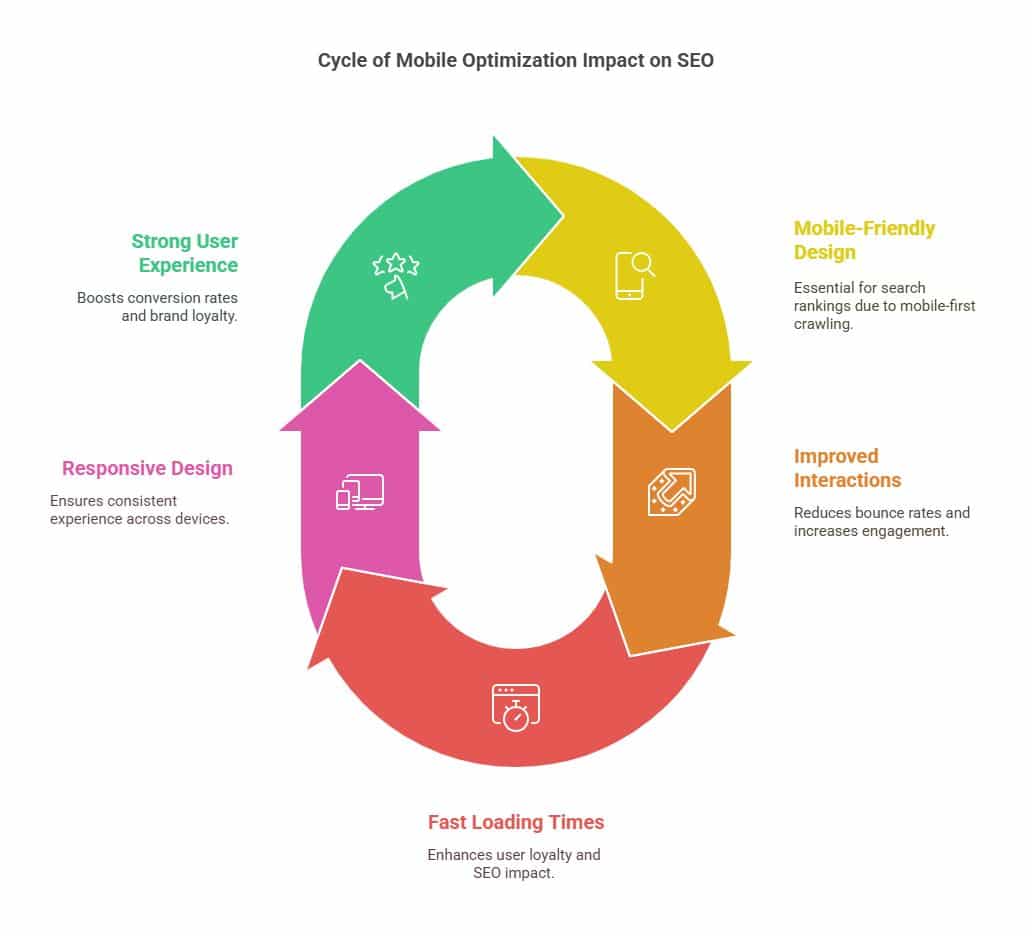
Why Does Mobile User Experience Matter for SEO?
Mobile user experience is crucial for SEO because it directly impacts how search engines rank websites and understand user interactions. A smooth mobile experience not only reduces bounce rates but also increases dwell time and makes your content more accessible. With mobile-first indexing becoming the norm, having touch-friendly navigation is essential, as search engines now prioritize sites that are optimized for mobile devices. Fast loading times and intuitive interfaces are key to keeping users satisfied, encouraging them to stay longer on your site, which positively affects your SEO performance. Plus, responsive design helps maintain a consistent look and feel across all devices, enhancing user engagement and sending strong signals to search engines. In today’s competitive digital landscape, putting mobile usability at the forefront is vital for boosting your visibility and keeping users coming back. There are plenty of insights to explore when improving mobile user experience for SEO.
Key Takeaways
- Due to search engines’ mobile-first crawling, mobile-friendly design is essential for search rankings.
- Improved touch interactions and navigation lower bounce rates, increasing user engagement and search engine optimization.
- Quick loading times enhance user loyalty and positively impact search engine rankings.
- Responsive design communicates optimization to search engines, ensuring a consistent user experience across devices.
- A strong mobile user experience boosts conversion rates, brand loyalty, and audience retention.

Impact of UX on SEO
Search engine optimization (SEO), which affects how search engines rank and interpret web content, is greatly impacted by the seamless integration of user experience (UX) into a website’s design. An optimal user experience (UX) is not merely a luxury; it is an essential part of a strong digital strategy.
Websites may guarantee that customers can simply find the material they’re looking for by concentrating on navigation optimization. This will lower bounce rates and increase dwell time, two important metrics that search engines take into account when evaluating rankings.
Content accessibility is another crucial aspect of UX that affects SEO. Ensuring that all users, including those with disabilities, can access and engage with content not only broadens a site’s audience but also aligns with search engines’ priorities for inclusive web design.
This accessibility directly influences search engine algorithms, which favor websites that cater to a diverse user base.
Visual hierarchy plays a pivotal role in guiding users through a website, emphasizing important information and facilitating content discovery. A well-structured hierarchy ensures that search engines better understand content relevance and context, enhancing overall SEO performance.
Interactive elements, such as buttons and forms, engage users and encourage interaction. These elements, when designed effectively, can lead to higher conversion rates and user satisfaction—factors that indirectly boost SEO by fostering a positive user experience.
Feedback mechanisms are integral to refining UX. By allowing users to provide input on their experience, websites can adapt and improve, ensuring ongoing alignment with user expectations and search engine criteria.
Mobile Experience and Rankings

In today’s digital landscape, optimizing mobile experience has become paramount for achieving high search engine rankings. With Google’s mobile first indexing, the importance of delivering a seamless mobile experience is more critical than ever. This approach prioritizes mobile-friendly websites in search results, making it essential for businesses to adapt.
- Touch Interactions: The rise of touch-based devices demands intuitive navigation and design. Websites must be optimized for touch interactions, ensuring users can easily swipe, tap, and scroll through content. A seamless touch experience not only enhances user satisfaction but also positively impacts search rankings.
- Screen Size Optimization: Mobile devices come in various shapes and sizes, requiring websites to be adaptable. Screen size optimization ensures that your site looks and functions well on any device, from smartphones to tablets. This adaptability is a key factor for maintaining a competitive edge in mobile search rankings.
- App-like Experiences: Users expect mobile websites to mimic the functionality of apps, offering fast load times and smooth transitions. By creating app-like experiences, businesses can engage users more effectively, reducing bounce rates and increasing dwell time—factors crucial for search engine ranking success.
- Local Search Relevance: With mobile devices often used on-the-go, local search relevance has gained importance. Businesses must ensure their mobile sites are optimized for local search to capture potential customers in nearby areas. Implementing local SEO strategies can significantly boost visibility and rankings.
Designing for User Engagement

Effective user engagement design is a cornerstone of a successful mobile user experience, deeply intertwined with search engine optimization strategies. In an era where users demand efficiency and immediacy, crafting interfaces that captivate and retain attention is paramount.
Visual hierarchy plays a pivotal role in guiding users through content, enabling them to discern vital information swiftly. By strategically prioritizing elements—such as headlines, images, and call-to-action buttons—businesses can direct user focus, thereby enhancing interaction rates and, consequently, their SEO performance.
Interactive elements are another critical component of user engagement. By integrating features like clickable buttons, sliders, and swipes, users are encouraged to explore more deeply, increasing time spent on a page. This boost in engagement signals to search engines that the content is valuable, ultimately improving organic rankings.
Moreover, content accessibility ensures that information is available to all users, regardless of potential physical limitations. By adhering to accessibility standards, businesses not only broaden their audience but also enhance their SEO credibility.
Touch gestures, such as pinching, swiping, and tapping, are intuitive actions that enhance user interaction. These gestures simplify navigation, allowing users to intuitively engage with content, thereby reducing frustration and enhancing satisfaction.
Coupled with navigation simplicity—wherein pathways through content are clear and concise—these elements form a cohesive user experience that fosters prolonged engagement.
Speed: Key to Success

Velocity is paramount in the realm of mobile user experience, significantly impacting both user satisfaction and search engine optimization. In today’s fast-paced digital world, users demand instantaneous access to information. A slow-loading mobile site can severely damage brand perception and drive potential customers away.
To harness the power of speed, businesses must prioritize mobile optimization and ensure that their user interface is engineered for swift performance.
Consider these four critical aspects that can influence the effectiveness of your mobile site:
- Loading Times: Swift loading times are vital. Websites that load in under three seconds are more likely to retain visitors, whereas slower sites experience higher bounce rates. This directly affects your SEO rankings as search engines prioritize fast, user-friendly websites.
- Mobile Optimization: Optimizing for mobile goes beyond just responsive design. It involves streamlining code, compressing images, and leveraging browser caching. Each element is crucial for delivering a seamless and rapid user experience.
- User Interface: A well-designed user interface enhances navigation and accessibility, ensuring users can swiftly locate the content they seek. An intuitive UI reduces frustration and keeps users engaged with your site, reducing the likelihood of them leaving prematurely.
- Content Accessibility: Ensuring content is easily accessible on mobile devices, with minimal barriers, is essential. A clean layout with strategically placed call-to-action buttons can significantly enhance user engagement and conversion rates.
Responsive Design Benefits
A well-executed responsive design is pivotal in enhancing the mobile user experience and boosting SEO performance. In today’s digital age, where power and influence are often determined by online presence, mastering responsive design is non-negotiable.
By employing adaptive layouts, businesses ensure their websites seamlessly adjust to various screen sizes, offering a consistent user experience across devices. This adaptability not only retains user engagement but also signals search engines that the website is well-optimized, thereby improving SEO rankings.
Touch optimization further complements adaptive layouts by enhancing the ease with which users interact with mobile websites. Precision in tap targets and intuitive gestures empower users, making navigation fluid and satisfying. A well-optimized touch experience reduces bounce rates, indicating to search engines that the site is both relevant and user-friendly.
Mobile navigation is another cornerstone of responsive design. Efficient mobile navigation ensures users can effortlessly find information, fostering longer site visits and reducing frustration. This ease of navigation is a testament to a website’s strategic design, reflecting an understanding of user behavior and preferences.
Content accessibility is crucial in a responsive design framework, ensuring that all users, regardless of device, can access information without barriers. This inclusivity is not just a moral imperative but a strategic advantage, as it broadens audience reach and engagement.
User Behavior Influences SEO

Understanding how user behavior influences SEO is paramount for achieving optimal search engine performance. In today’s digital landscape, search algorithms are increasingly sophisticated, assessing not only the keywords but also the intent behind user searches. This evolving focus on user intent has transformed how websites must approach their content strategy, particularly in the realm of mobile optimization.
- Behavioral Metrics: Search engines evaluate how users interact with a site to determine its value. Metrics such as bounce rate, time on site, and pages per visit provide insight into content relevance and user satisfaction. A high bounce rate, for instance, might indicate that the content failed to meet the user’s expectations or intent.
- Content Relevance: Ensuring content is aligned with user intent enhances its relevance, thus improving SEO performance. Content that directly answers user queries or provides significant value is more likely to engage visitors, reducing bounce rates and increasing dwell time—key factors in search algorithm evaluations.
- Mobile Optimization: The surge in mobile search emphasizes the need for seamless mobile experiences. Websites optimized for mobile devices not only cater to user preferences but also align with search engine priorities, as mobile-friendliness is a critical ranking factor.
- User Intent Alignment: Understanding and anticipating user intent allows for the creation of content that resonates with target audiences. This strategic alignment ensures that the content is not only discoverable but also engaging, fostering stronger user interactions and improving overall SEO outcomes.
In essence, mastering user behavior insights is a powerful lever for enhancing SEO, positioning your site as a leader in the digital domain.
Competitive Advantage

Building on the understanding of user behavior’s impact on SEO, leveraging these insights can offer a significant competitive edge. In today’s digital landscape, mobile usability is not just a matter of convenience; it’s a strategic imperative. Businesses that prioritize exceptional mobile experiences are positioned to dominate their markets. A seamless mobile interface enhances user satisfaction, ensuring that visitors not only stay longer on a site but also engage more deeply with its content. This engagement directly influences conversion rates, transforming casual browsers into loyal customers.
In the fiercely competitive arena of digital marketing, audience retention is a key determinant of success. Mobile users demand quick, intuitive interactions, and businesses that meet these expectations are rewarded with sustained user interest. This retention fosters brand loyalty, as users are more likely to return to a site that consistently delivers a superior mobile experience.
In essence, a robust mobile strategy not only attracts but retains a valuable audience, setting a business apart from its competitors.
Moreover, as search engines increasingly prioritize mobile-friendly sites in their rankings, optimizing for mobile usability becomes a crucial factor in achieving and maintaining top search engine positions. Companies that excel in this area gain visibility and authority—powerful assets in the digital age.
Thus, investing in mobile user experience is not merely a tactical decision; it is a strategic move that can secure long-term competitive advantages. By focusing on enhancing mobile usability, businesses can optimize their conversion rates, ensure audience retention, and cultivate unwavering brand loyalty.
Final Thoughts
In today’s digital landscape, prioritizing mobile user experience is essential for successful SEO. As search engines increasingly favor mobile-friendly sites, businesses must ensure their websites are not only visually appealing but also easy to navigate, fast-loading, and accessible across various devices. By optimizing touch interactions and refining content to meet the needs of mobile users, companies can significantly enhance user satisfaction and engagement. Additionally, leveraging local SEO strategies and implementing responsive design further solidifies a website’s position in search rankings.
Looking to optimize your website for mobile SEO and boost your search rankings? Connect with Syville Gacutan, an experienced SEO Specialist in the Philippines. With proven expertise in mobile optimization, local SEO, and user experience enhancement, Syville can help your business achieve lasting digital success. Contact Syville today and start transforming your mobile site’s SEO performance.